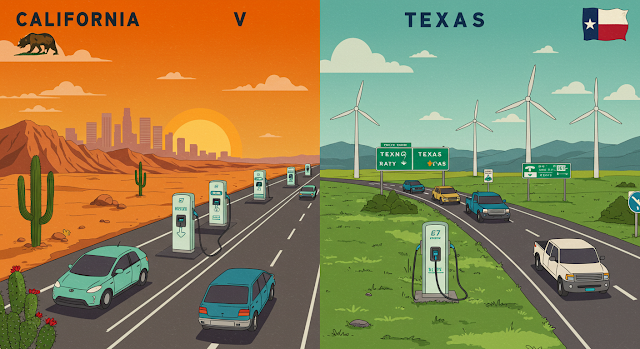Electric vehicles (EVs) are no longer a futuristic concept – they are now a vital part of the American automotive landscape. Yet, when we zoom in on adoption trends across different states, stark contrasts begin to emerge. Today, we're diving into a fascinating comparison: California vs Texas – what drives the gap in EV adoption rates between these two powerhouse states?
California: The Nation’s EV Trailblazer
There’s no question about it – California is the undisputed leader in EV adoption in the United States. Cities like Los Angeles, San Francisco, and San Diego boast some of the highest EV penetration rates in the country. As of 2023, EVs made up approximately 21% of new vehicle sales in California – nearly three times the national average of 7.6%. In fact, over 1 million EVs have been registered in California, accounting for roughly 40% of all EVs in the U.S.
So, what’s powering California’s EV boom?
-
Aggressive Policies & Incentives:
California’s environmental commitment is second to none. The Advanced Clean Cars II program mandates that all new vehicle sales must be zero-emission (EVs or hydrogen vehicles) by 2035. Buyers can receive up to $7,500 in federal tax credits, plus additional state-level rebates, and HOV lane access regardless of occupancy. -
Robust Charging Infrastructure:
With more than 90,000 public charging stations, California hosts over 25% of the nation’s chargers. Whether you're in a major metro or on the Pacific Coast Highway, chances are you’re within reach of a charger – a key reason for lower range anxiety. -
Environmental & Tech-Friendly Culture:
Californians are environmentally conscious and tech-forward. With Tesla’s headquarters once in Palo Alto and a strong startup ecosystem, EVs are seen not just as transportation, but as part of a sustainable lifestyle.
Texas: The Sleeping Giant of EV Growth
Texas is the second-largest car market in the U.S., but its EV adoption is still catching up. In 2023, only about 3–4% of new vehicle sales were electric. While Austin, Houston, and Dallas are showing signs of growth, EVs remain a small fraction of the total vehicle fleet, with only around 150,000 EVs registered – about 1/6th of California’s total.
Why is Texas behind – and where is it catching up?
-
Lack of Incentives & Added Fees:
Texas does not offer any state-level EV rebates, and instead charges a $200 annual EV registration fee. With deep roots in oil and gas, the state’s policies reflect a more cautious approach toward electrification. -
Infrastructure Gaps:
Texas covers a massive land area – 1.6 times larger than California – but has only around 6,000 public chargers, about 1/15th of California’s total. In a state where long-distance driving is common, this infrastructure gap remains a major barrier. -
Cultural Factors:
In Texas, pickup trucks and large SUVs dominate the roads. Many residents prioritize power and range over sustainability. EVs are still seen by some as less practical or even ideological, although cities like Austin are shifting this narrative.
Urban vs Rural: A Hidden Layer
Both states reflect a sharp urban-rural divide. In dense cities, public charging access and awareness are better, driving higher EV uptake. In contrast, rural areas often lack chargers and view EVs as incompatible with long-distance, heavy-use lifestyles.
What Sets Them Apart?
Ultimately, the EV adoption gap between California and Texas stems from three core differences:
- Policy Direction: California actively incentivizes EVs to meet climate targets. Texas maintains traditional energy priorities, with minimal policy support.
- Infrastructure Density: California offers 0.2 chargers per square mile, compared to just 0.02 in Texas.
- Public Sentiment: In California, EVs are part of the mainstream. In Texas, they're still often seen as niche or impractical – with 60% of Californians open to EVs vs less than 30% in Texas.
What Lies Ahead?
California is well-positioned to reach a future where over 50% of vehicles are electric by the 2030s. Texas, meanwhile, could become a fast riser, especially with Tesla’s Gigafactory in Austin and increasing investments in infrastructure. However, without significant policy shifts and rural investment, the California-Texas gap may persist.
As someone who has driven EVs in both states, I’ve felt the difference firsthand. In Los Angeles, fast chargers are at nearly every grocery store. In rural Texas, I once detoured 40 minutes just to find a charger. But the momentum is building – and the EV transformation is coming to all corners of America.
-EditorZ


Post a Comment